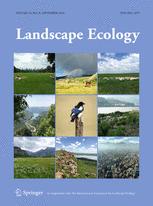View Item
- xmlui.general.dspace_homeCentros e Institutos de InvestigaciónCIRN. Centro de Investigaciones de Recursos NaturalesInstituto de Recursos BiológicosArtículos científicosxmlui.ArtifactBrowser.ItemViewer.trail
- DSpace Home
- Centros e Institutos de Investigación
- CIRN. Centro de Investigaciones de Recursos Naturales
- Instituto de Recursos Biológicos
- Artículos científicos
- View Item
Effects of past and future land conversions on forest connectivity in the Argentine Chaco
Abstract
Context:
Land-use change is the main driver of habitat loss and fragmentation worldwide. The rate of dry forest loss in the South American Chaco is among the highest in the world, mainly due to the expansion of soybean production and cattle ranching. Argentina recently implemented a national zoning plan (i.e., the Forest Law) to reduce further forest loss. However, it is unclear how the effects of past deforestation and the implementation of the Forest
[ver mas...]
Context:
Land-use change is the main driver of habitat loss and fragmentation worldwide. The rate of dry forest loss in the South American Chaco is among the highest in the world, mainly due to the expansion of soybean production and cattle ranching. Argentina recently implemented a national zoning plan (i.e., the Forest Law) to reduce further forest loss. However, it is unclear how the effects of past deforestation and the implementation of the Forest Law will affect forest connectivity in the Chaco.
Objective:
Our main goal was to evaluate the potential effect of the Forest Law on forest fragmentation and connectivity in the Argentine Chaco.
Methods:
We studied changes in the extent, fragmentation, and connectivity of forests between 1977 and 2010, by combining agricultural expansion and forest cover maps, and for the future in a scenario analysis.
Results
Past agricultural expansion translated into an overall loss of 22.5 % of the Argentine Chaco’s forests, with deforestation rates in 2000–2010 up to three times higher than in the 1980s. Forest fragmentation and connectivity loss were highest in 1977–1992, when road construction fragmented large forest patches. Our future scenario analysis showed that if the Forest Law will be implemented as planned, forest area and connectivity in the region will decline drastically.
Conclusions:
Land-use planning designed to protect stepping stones could substantially mitigate connectivity loss due to deforestation, with the co-benefit of preserving the greatest amount of biodiversity priority areas across all evaluated scenarios. Including scenario analyses that assess forest fragmentation and connectivity at the ecoregion scale is thus important in upcoming revisions of the Argentine Forest Law, and, more generally, in debates about sustainable resource use.
[Cerrar]

Author
Piquer Rodriguez, María;
Torella, Sebastián Andrés;
Gavier Pizarro, Gregorio Ignacio;
Volante, Jose Norberto;
Somma, Daniel Jorge;
Ginzburg, Rubén G.;
Kuemmerle, Tobias;
Fuente
Landscape ecology 30 (5) : 817–833. (May 2015)
Date
2015-05
Editorial
Springer
ISSN
0921-2973
1572-9761 (Online)
1572-9761 (Online)
Formato
pdf
Tipo de documento
artículo
Palabras Claves
Derechos de acceso
Restringido
 Excepto donde se diga explicitamente, este item se publica bajo la siguiente descripción: Creative Commons Attribution-NonCommercial-ShareAlike 2.5 Unported (CC BY-NC-SA 2.5)
Excepto donde se diga explicitamente, este item se publica bajo la siguiente descripción: Creative Commons Attribution-NonCommercial-ShareAlike 2.5 Unported (CC BY-NC-SA 2.5)

